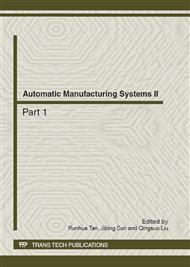p.976
p.981
p.985
p.989
p.993
p.997
p.1001
p.1007
p.1011
Research on Nozzle Array Structure Fluidic Gyroscope Sensitive Principle
Abstract:
The fluidic gyroscope sensitive principle with nozzle array structure was researched. Using the finite element method, according to the actual size, building an entity model, the finite element simulation was conducted by a series of procedures, such as meshing, loads applying and solving. Then the cavity flow field distribution was calculated in the different input angular rate. The results are as follows: In static status, airflow velocity shows a symmetry distribution through central axis of enclosure, the two hotwires endure the same current rate and current, then the bridge outputs zero. In the angular rate inputs, airflow velocity shows an asymmetry distribution through central axis of cavity. The two hotwires endure the different current rate, both of the hotwires current are changed with angular rate, then the bridge outputs a voltage with corresponding with the angular rate. The fluidic gyroscope sensitive principle with nozzle array structure is revealed by finite element method, which provides the foundation for the fluidic gyroscope structural and performance improvement.
Info:
Periodical:
Pages:
993-996
Citation:
Online since:
June 2012
Authors:
Price:
Сopyright:
© 2012 Trans Tech Publications Ltd. All Rights Reserved
Share:
Citation:


